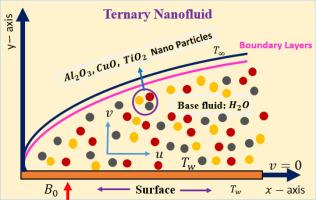A machine learning technique for computational analysis of EMHD ternary nanofluid with heat generation: Al2O3+CuO+TiO2/water
引用次数: 0
Abstract
In order to model ternary nano fluid EMHD flow with internal heat generation, we present a machine learning approach. In this case, traditional numerical methods are often computationally difficult to apply on such complex systems. Ternary nanofluids enhance the efficiency of solar thermal systems by a large margin compared to single or binary nanofluids because of the significant enhancement of heat transport in ternary nanofluids. Similarity transformations are applied to the governing PDEs that are solved with the MATLAB bvp4c solver. Effects of key factors on flow and thermal behaviour are identified by the use of numerical simulations; effects of friction factor and Nusselt number are checked by means of tabular and graphical data.
The trained machine learning model estimates parameters of temperature, velocity, and heat transport more accurately than the traditional techniques. The model fits numerical simulations efficiently by taking into account magnetic field effects and heat generation. In terms of prediction, justification, and optimisation, Artificial Neural Networks (ANNs) perform better than conventional regression approaches. Exactness and generalisation are guaranteed by using 80 % of the bvp4c-generated data for training and 20 % for testing. Regression analysis (for both temperature and velocity) reveals a low mean squared error (MSE ∼ 10−5) and a closely perfect correlation coefficient (R = 1). Strong agreement across all data subsets is shown by regression graphs and error histogram. A potential paradigm for improving thermal system design in industrial, aerospace, and energy applications is presented by this AI-CFD integration.

Al2O3+CuO+TiO2/water三元产热EMHD纳米流体计算分析的机器学习技术
为了模拟三元纳米流体EMHD内部产生热量的流动,我们提出了一种机器学习方法。在这种情况下,传统的数值方法在计算上往往难以适用于这种复杂的系统。与单一或二元纳米流体相比,三元纳米流体极大地提高了太阳能热系统的效率,因为三元纳米流体显著增强了热传递。利用MATLAB bvp4c求解器对控制偏微分方程进行相似变换。通过数值模拟确定了影响流动和热行为的关键因素;用表格和图形的方法检验了摩擦系数和努塞尔数的影响。经过训练的机器学习模型比传统技术更准确地估计温度、速度和热传输参数。该模型考虑了磁场效应和热产生的影响,有效地拟合了数值模拟结果。在预测、论证和优化方面,人工神经网络(ann)比传统的回归方法表现得更好。bvp4c生成的数据中80%用于训练,20%用于测试,保证了准确性和泛化性。回归分析(温度和速度)显示了较低的均方误差(MSE ~ 10−5)和密切完美的相关系数(R = 1)。回归图和误差直方图显示了所有数据子集之间的强一致性。AI-CFD集成为改善工业、航空航天和能源应用中的热系统设计提供了一个潜在的范例。
本文章由计算机程序翻译,如有差异,请以英文原文为准。
求助全文
约1分钟内获得全文
求助全文

 求助内容:
求助内容: 应助结果提醒方式:
应助结果提醒方式:


